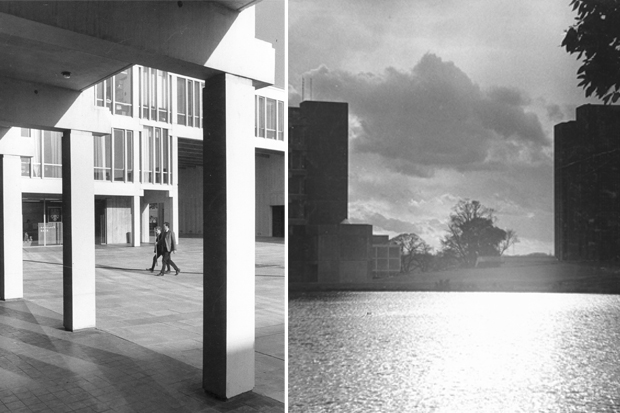We are told this is now a ‘knowledge economy’. Strange, then, that there are so few recent educational buildings of note. An expansion of universities has not led to much enlightened architectural patronage. Rather the opposite, in fact. The university visual trope remains those dogged dreaming spires. And London’s skyline is punctuated not by grand monuments to learning but by the swaggering, leering one-liners of the global plutocracy.
These are thoughts that come to mind on the occasion of Essex University’s 50th birthday, a much more interesting anniversary than it first (rather bleakly) sounds. It is the subject of an engaged and engaging booklet, Something Fierce, and an on-campus exhibition curated by Jules Lubbock, Essex’s emeritus professor of art history.
Lubbock is an inspirational teacher and a contrarian of genius. I know: in an earlier life for both of us, he taught me. I fondly remember a lecture about Fra Angelico where he read explicatory passages from a book about cybernetic theory. This refusal to acknowledge disciplinary boundaries was a founding principle of Essex.
So, too, was it a principle of John Henry, later Cardinal, Newman. In his 1852 book of lectures, talks and articles, The Idea of a University, Newman argued for an academic community arranged on non-denominational lines and with no specialisations other than the noble ‘perfection of the intellect’. He wanted to teach not narrow subjects but strategies for thinking, analysis and discrimination. Helpful, one imagines, in writing today’s all-important code. Additionally, Newman believed that a university should have a soul. Essex has soul in spades, if not quite the sort Newman had in mind.
It was very much the creation of an extraordinary individual. Albert Sloman had intended to do PPE at Oxford, but was diverted to Spanish by the egregious Maurice Bowra. In 1953, aged a mere 32, Sloman, with a fine record as a second world war airman, took up the Gilmour Chair of Spanish at Liverpool University. Here he succeeded Edgar Allison Peers who, under the pseudonym ‘Bruce Truscot’, gave the world an unforgettable term in his 1943 fantasy polemic about academic principles, Redbrick University. Architecture inspired the title: Liverpool University’s heart (and soul) is Alfred Waterhouse’s magnificently shiny redbrick Victoria Building of 1892.
Sloman wanted to redefine not just the university curriculum, but the architectural character of the university too. Essex was conceived in contrast to Liverpool and the other sprawling metropolitan redbrick universities of the 19th century. It was to be uncompromisingly modern and sited on an out-of-town greenfield site, in this case picturesque Wivenhoe Park near Colchester, which Constable once painted.
Oxbridge stairs were replicated in tower-blocks, rather as Le Corbusier said he was building ‘vertical garden cities’. The academic body, staff and students alike, was committed (at least by Sloman) to the unity of knowledge: specialisation occurred only at post-graduate level. Sloman, an authority on Spanish mysticism, could dismantle an aircraft engine. When it came to the interdisciplinary, the style was the man.

The designer of Essex’s buildings was Kenneth Capon of the Architects’ Co-Partnership, a firm whose very name hints at high-minded collectivism. Indeed, it was a take on the much larger US firm the Architects’ Collaborative, headed by Walter Gropius, founder of Bauhaus, whose motto was ‘Art and Technology: a new unity’. An early proposal for the Essex campus was made of Lego.
Sloman’s and Capon’s vision was to create a replica MIT, a factory-cathedral producing the educated brainpower to fuel economic growth. That the early history of Essex comprised serial and well-publicised sit-ins and lockouts by stoned malcontents does not mean that vision lacked poetry and grandeur.
Not every Essex building is, by current aesthetic criteria, a delight; indeed, it was the intention of Sloman and Capon to create ‘Something Fierce’, a designed environment that was actively stimulating. In the days before high-rise was discredited, Capon had unsuccessfully proposed four high-rise towers for Churchill College, Cambridge: ‘a spiky verticality of pinnacles against an open sky’, he called it. That vision was, at least in part, realised in Essex. But along with the towers, built of structural brick, there were bold squares and striking colonnades. It was not, in Capon’s words, ‘shaggy and soft’, but it was powerful and principled.
In 1963 Winston Churchill was an Essex MP and became an unlikely, but welcome, donor to and supporter of this radical institution. He once said we form our buildings and then our buildings form us. Never was this more true than of universities.

There is something heroic about Essex and its successors at Kent, Sussex and East Anglia. They have their absurdities: Kent was rumoured to have been designed as a prison in Venezuela, but rejected by the authorities on humanitarian grounds. Sussex was Basil Spence channelling Le Corbusier in Brighton. East Anglia had Denys Lasdun doing slightly bonkers Formgebung in Norwich.
But each had energy, optimism and enthusiasm: Hardy Amies designed Essex’s academic robes! You look in vain for energy, optimism and enthusiasm — let alone style — in universities today.






Comments